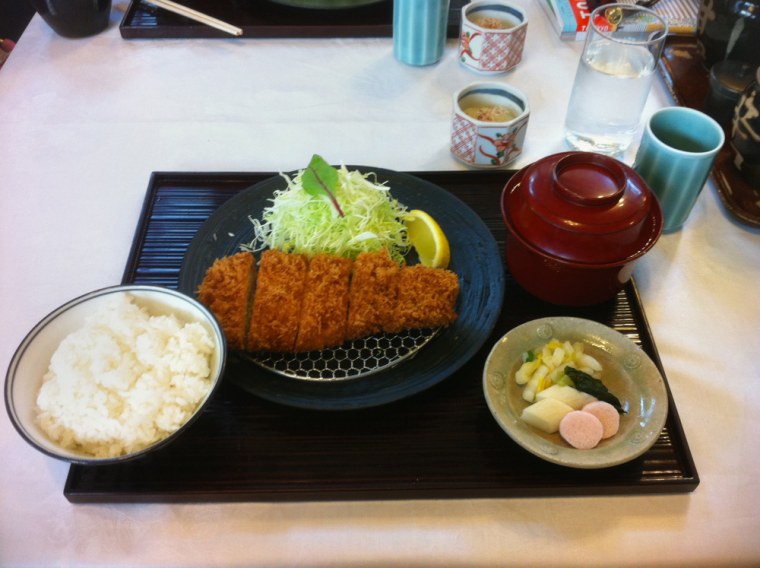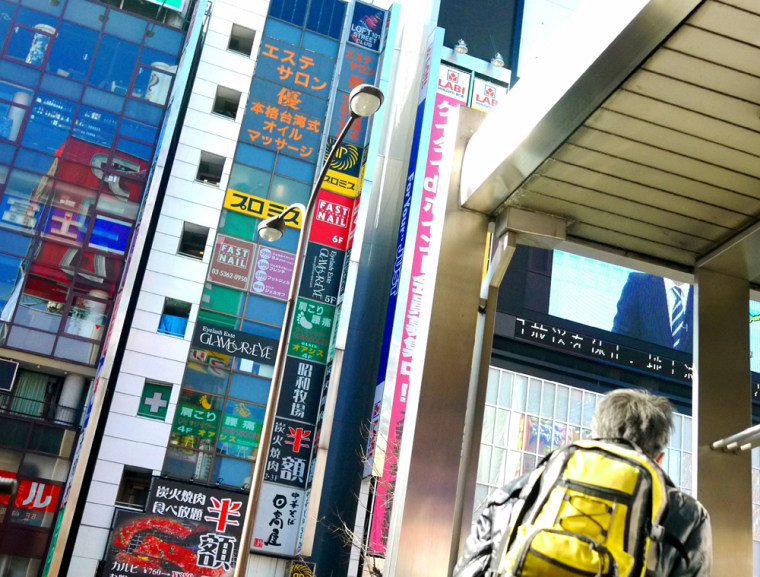Tokyo was gorgeous on Sunday. Even at 8 a.m., the sun glared down brightly on a city that had shaken violently just days before, and is still experiencing mental echoes and physical aftershocks of that first, massive temblor. That tension between sunny tourism — a novice encounter with a great and complex city — and the terrible news still unfolding north of the Japanese capital defined a brief visit here.
My girlfriend and I arrived at Haneda airport Saturday night, after an unexpected 18-hour layover in Anchorage, where our non-stop flight from JFK had diverted after the quake. Haneda is a gleaming, clean and efficient facility. Clearing immigration and customs was a breeze, and there weren't any obviously stranded passengers anywhere in the international terminal. It was an apt introduction: During our stay in Tokyo we didn’t see any physical earthquake damage.
We'd expected to take the express train into Tokyo, but it, like much of Tokyo's rail infrastructure, had been shut down. The bus was an easy alternative. At the stop, I fiddled with my phone settings and got local mobile service. A backlog of breaking news alerts popped up. The most recent: "BREAKING: Explosion rocks earthquake-hit Japanese nuclear plant.”
On arriving at Shinjuku, one of the 23 city wards of Tokyo, we quickly got a little lost walking around a mix of big boulevards and very cool neon-lit warrens of shops and cafes. The streets and sidewalks weren't empty of cars and pedestrians, but weren't busy. Far more taxis were sitting in queues than ferrying fares.
A friendly guide
After a few wandering turnarounds, a friendly Welshman named Peter noticed us staring quizzically at a map and offered to walk us to our hotel. Peter, a 20-year resident of Tokyo who lives in the neighborhood, was out for a walk. He said that for 9 p.m. on a Saturday — or any night, really — the normally busy streets of Shinjuku were shockingly empty.
He wasn't surprised. He and his workmates had rushed out of their office during Friday's quake. They were scared of collapse: "You could see buildings like that moving like this," he said, pointing straight up towards a cluster of skyscrapers and pivoting his forearm rapidly back and forth, an unscientific but scary swing of about 20 degrees.
Everybody camped out in their offices after that, he said. "Once they got home, they didn't want to come back out."
At a crosswalk with a "Don't walk" sign, he said, "Come on, we can cross. It's a special weekend."
On the approach to our hotel, Peter made sure we were aware of the nuclear reactor explosion and suggested we monitor the TV in our room for news of possible fallout and any change in wind direction toward Tokyo.
"Hopefully it's not like Chernobyl," he said.
We shook hands goodbye and Peter said "Enjoy your time."
Our hotel room was tiny but comfortable. We washed up with the news on, unable to really tell what was happening at the Fukushima Daiichi nuclear complex after the reactor explosion, or what it could mean for Tokyo.
Soba noodles and high-tech bidets
The Toto toilet had a computer-controlled bidet that took some figuring out. I'll leave it at that.
Out we went, looking for a ramen shop with a little help from the front desk. Just up the street from the hotel were shops decorated with pictures of pretty women in lingerie. Touts asked single men, and some not-so-single men, whether they wanted "to do something tonight." It was obvious then that the services on offer in the neighborhood sometimes exceeded massage. Today, two tweets from @TokyoReporter suggested that such establishments weren’t immune to the shaking fear that accompanied Friday’s quake in Tokyo.
We walked on to the recommended noodle spot, pushed the button on the sliding glass door once we figured out that's how to swoosh it open, and were promptly ushered back outside by a counterman.
He used his hands to explain that we were to find what we wanted from the plastic models in the sidewalk display, then pay in the vending machine next to it, press the number of our dish, retrieve our ticket, go back inside, deliver it to the counterman, and have a seat.
We each had soba noodles in a miso base, mine topped with sliced roast pork and hers with a long piece of shrimp tempura. Except it wasn't shrimp, it was a slice of a large octopus tentacle, and it was plenty tasty. To me.
Back in the room, we watched TV for more information about the nuclear situation about 170 miles north of us. In the middle of the night I half-woke just long enough for my girlfriend to tell me that she'd just felt an aftershock.
We rose at 7 a.m. to a sunny day and a deadline: we had to get to the airport bus by 2 p.m. to get to Narita airport in time to catch our evening flight to Manila.
A quick breakfast preceded a brisk walk to the train station for the subway to Tsukijishijo. We planned to eat some of the world’s freshest sushi in the shops just outside the city’s main fish market, but we arrived there to find them all shuttered. A few workers were sitting on a cart, sharing breakfast and a bottle of rice wine, so we asked them if the market was shut because of the tsunami. One of them, a woman in coveralls, said “no” and explained: “It’s Sunday.”
I never said I was an old Tokyo hand, much less a professional traveler. So I can only offer our mistake as a simple lesson for you if you need it: Read your guidebook closely.
Hipster shops and black pigs
The subway spirited us away to Harajuku, where narrow streets lined with clothing and accessory shops were busy with pedestrians. I need a baseball cap for the Philippine beach, so I ducked into a shop offering “Hip-Hop” items, including a wide selection of sneakers and Major League Baseball caps, to see if I could find a Detroit Tigers New Era with the road orange “D.”
The storekeeper was a young man clad in Yankees cap, thick plastic glasses, scraggly goatee, T-shirt, baggy jeans and high-end sneakers. He asked when we’d arrived, and noted that we missed the earthquake. My girlfriend asked him what it was like. “Scary,” he said, “everything was moving so much,” and he widened his stance and mimed a wide fast back-and-forth sway. If you’re telling someone about your experience of an earthquake, words aren’t enough. You need to use your body to show what it was like.
He offered discounts on everything, but we just wished him safety and walked back out into Harajuku, looking for lunch.
Our guidebook said Maisen, located in a converted bathhouse, was a good bet for fried pork cutlets. The short walk there led us through a mixed neighborhood of hair salons and very nice residences, none of which showed any obvious signs of earthquake damage. The restaurant was high-ceilinged, with prompt delivery of the house specialty, described on the menu:
“Kurobuta, literally "black pig," is the Japanese term for Berkshire pigs. "Satsuma" is a district in Kagoshima Prefecture and "Roppaku Kurobuta' are six-spotted kurobuta.”
If you asked me to name the best pig-based restaurant meal I’ve enjoyed, a few would come to mind. Momofuko’s bo ssam in New York is one. The swine-centric course at Cochon in New Orleans is another. As of today, the lightly breaded, delectably smooth Berkshire cutlet, spooned over with Maisen’s special sauce, is in contention. I’ll remember it, and speak of it to friends, whenever I describe my first earthquake-addled visit to Tokyo.

At lunch’s end, we had just enough time to hop the subway back to Shinjuku for the bus ride to Narita. Delta’s check-in line at the international terminal appeared interminable. An entrance attendant said the queue was made up of folks whose flights had been canceled in previous days. My girlfriend is a Delta Medallion frequent flyer, so we were lucky (we’ve been so lucky, these past few days) to be able to join the short premium class line to check in for our roughly on-time flight to Manila.
Collecting thoughts
I have many mixed feelings at the end of my first day in Tokyo.
First and foremost, I think of the victims in the north of Japan: Those who have passed away; their families; people without water or food; and folks under threat of possible irradiation.
It’s not the first bright day I’ve seen after a tragedy. I remember the sunny weekend after 9/11 in New York: A string quartet playing Bach in Union Square; the frowns painted on clowns’ faces in Washington Square Park; the faces of the missing, often smiling, looking out from flyers everywhere. I empathize.
Second, I’m still a tourist (albeit a journalist on vacation from a newsroom working its collective ass off to cover this story). So I’ll do my best to enjoy memories of modishly dressed Japanese kids, the irony of a suited office man pulling down his sanitary face mask to smoke a cigarette, the taste of octopus tempura.
I’ll be back. First, for another short day on the return to New York in a little more than a week. And not a Sunday, either. We’ll eat sushi at the fish market, and soon.
But that won’t be my last visit. I could spend weeks, months, even years here, and feel as torn about leaving the durable city of Tokyo as I do about leaving the immediate story of the quake’s aftermath. Trying to experience a great city like Tokyo in a day is a fool’s errand, hinting insistently at the deeper joys to be had with a longer commitment.
